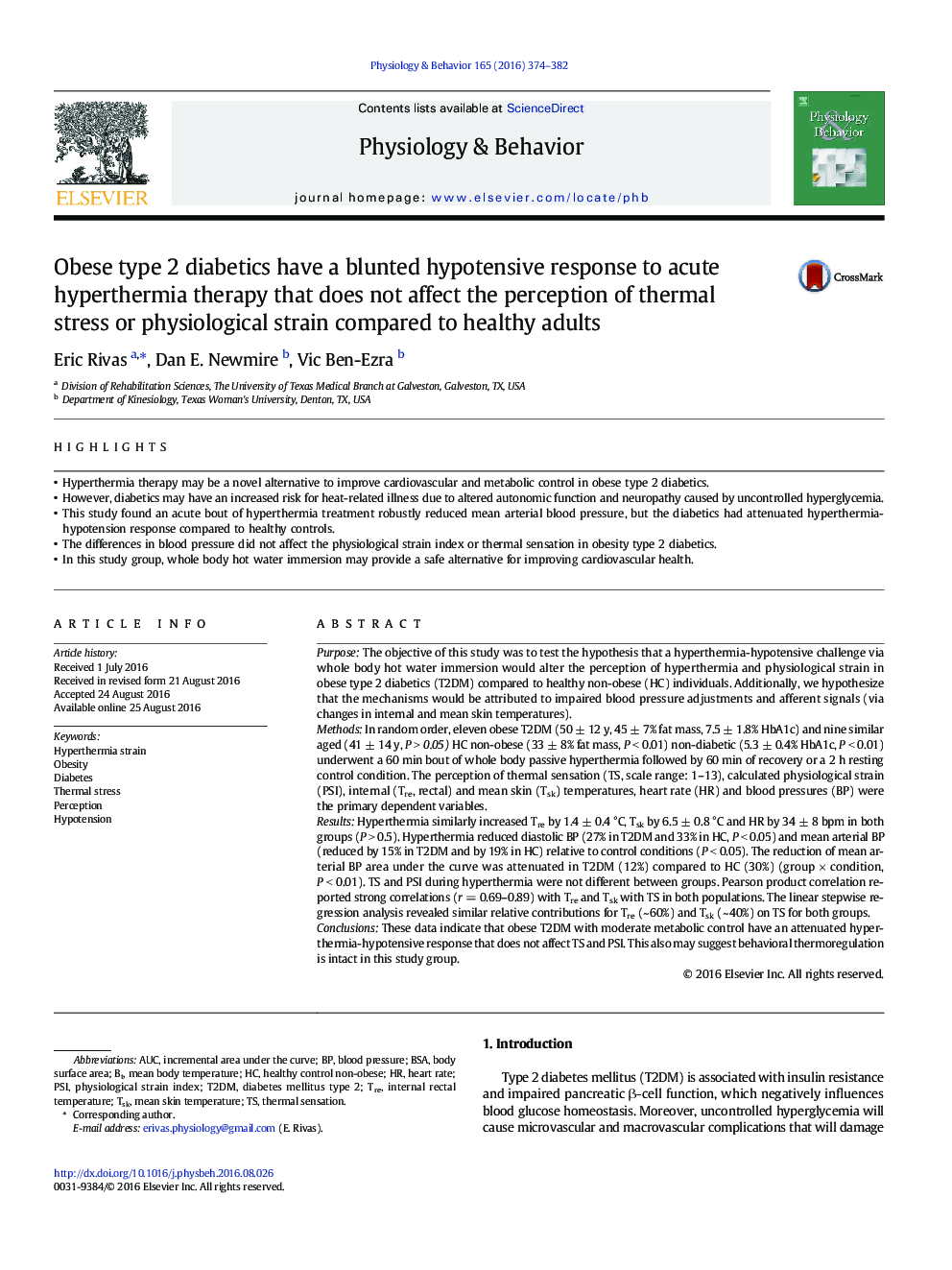| کد مقاله | کد نشریه | سال انتشار | مقاله انگلیسی | نسخه تمام متن |
|---|---|---|---|---|
| 5922837 | 1571154 | 2016 | 9 صفحه PDF | دانلود رایگان |
- Hyperthermia therapy may be a novel alternative to improve cardiovascular and metabolic control in obese type 2 diabetics.
- However, diabetics may have an increased risk for heat-related illness due to altered autonomic function and neuropathy caused by uncontrolled hyperglycemia.
- This study found an acute bout of hyperthermia treatment robustly reduced mean arterial blood pressure, but the diabetics had attenuated hyperthermia-hypotension response compared to healthy controls.
- The differences in blood pressure did not affect the physiological strain index or thermal sensation in obesity type 2 diabetics.
- In this study group, whole body hot water immersion may provide a safe alternative for improving cardiovascular health.
PurposeThe objective of this study was to test the hypothesis that a hyperthermia-hypotensive challenge via whole body hot water immersion would alter the perception of hyperthermia and physiological strain in obese type 2 diabetics (T2DM) compared to healthy non-obese (HC) individuals. Additionally, we hypothesize that the mechanisms would be attributed to impaired blood pressure adjustments and afferent signals (via changes in internal and mean skin temperatures).MethodsIn random order, eleven obese T2DM (50 ± 12 y, 45 ± 7% fat mass, 7.5 ± 1.8% HbA1c) and nine similar aged (41 ± 14 y, P > 0.05) HC non-obese (33 ± 8% fat mass, P < 0.01) non-diabetic (5.3 ± 0.4% HbA1c, P < 0.01) underwent a 60 min bout of whole body passive hyperthermia followed by 60 min of recovery or a 2 h resting control condition. The perception of thermal sensation (TS, scale range: 1-13), calculated physiological strain (PSI), internal (Tre, rectal) and mean skin (Tsk) temperatures, heart rate (HR) and blood pressures (BP) were the primary dependent variables.ResultsHyperthermia similarly increased Tre by 1.4 ± 0.4 °C, Tsk by 6.5 ± 0.8 °C and HR by 34 ± 8 bpm in both groups (P > 0.5). Hyperthermia reduced diastolic BP (27% in T2DM and 33% in HC, P < 0.05) and mean arterial BP (reduced by 15% in T2DM and by 19% in HC) relative to control conditions (P < 0.05). The reduction of mean arterial BP area under the curve was attenuated in T2DM (12%) compared to HC (30%) (group Ã condition, P < 0.01). TS and PSI during hyperthermia were not different between groups. Pearson product correlation reported strong correlations (r = 0.69-0.89) with Tre and Tsk with TS in both populations. The linear stepwise regression analysis revealed similar relative contributions for Tre (~ 60%) and Tsk (~ 40%) on TS for both groups.ConclusionsThese data indicate that obese T2DM with moderate metabolic control have an attenuated hyperthermia-hypotensive response that does not affect TS and PSI. This also may suggest behavioral thermoregulation is intact in this study group.
Journal: Physiology & Behavior - Volume 165, 15 October 2016, Pages 374-382
